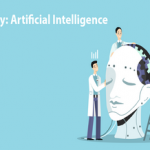Cloud Computing: Cloud computing is a concept used to describe a variety of computing concepts that involve a large number of computers connected through a real-time communication network such as the Internet. In science, cloud computing is a synonym for distributed computing over a network, and means the ability to run a program or application on many connected computers at the same time. The phrase also more commonly refers to network-based services, which appear to be provided by real server hardware, and are in fact served up by virtual hardware, simulated by software running on one or more real machines. Such virtual servers do not physically exist and can therefore be moved around and scaled up (or down) on the fly without affecting the end user – arguably, rather like a cloud.
API: An application programming interface (API) specifies how some software components should interact with each other.
An API specification can take many forms, including an International Standard such as POSIX, vendor documentation such as the Microsoft Windows API, the libraries of a programming language, e.g., Standard Template Library in C++ or Java API. Web APIs are also a vital component of today’s web fabric.
Cloud API: Application programming interfaces (APIs) used to build applications in the cloud computing market. Cloud APIs allow software to request data and computations from one or more services through a direct or indirect interface. Cloud APIs most commonly expose their features via REST and/or SOAP. Vendor specific and cross-platform interfaces are available for specific functions.
Platform as a service (PaaS): Along with software as a service (SaaS) and infrastructure as a service (IaaS), it is a service model of cloud computing. In this model, the consumer creates the software using tools and/or libraries from the provider. The consumer also controls software deployment and configuration settings. The provider provides the networks, servers, storage, and other services that are required to host the consumer’s application.
Infrastructure as a service (IaaS): In the most basic cloud-service model, providers of IaaS offer computers – physical or (more often) virtual machines – and other resources.
IaaS clouds often offer additional resources such as a virtual-machine disk image library, raw (block) and file-based storage, firewalls, load balancers, IP addresses, virtual local area networks (VLANs), and software bundles. IaaS-cloud providers supply these resources on-demand from their large pools installed in data centers. For wide-area connectivity, customers can use either the Internet or carrier clouds (dedicated virtual private networks).
Testing as a Service (TaaS): An outsourcing model in which testing activities associated with some of an organization’s business activities are performed by a service provider rather than employees.
TaaS may involve engaging consultants to help and advise employees or simply outsourcing an area of testing to a service provider.
Thin Client: A computer or a computer program which depends heavily on some other computer (its server) to fulfill its computational roles. This is different from the traditional fat client, which is a computer designed to take on these roles by itself. The specific roles assumed by the server may vary, from providing data persistence (for example, for diskless nodes) to actual information processing on the client’s behalf.
Thick Client: A computer (client) in client–server architecture or networks that typically provides rich functionality independent of the central server. Originally known as just a “client” or “fat client”, the name is contrasted to thin client, which describes a computer heavily dependent on a server’s applications.
Hybrid Cloud: Hybrid cloud is a composition of two or more clouds (private, community or public) that remain unique entities but are bound together, offering the benefits of multiple deployment models.
Sandbox: A testing environment that isolates untested code changes and outright experimentation from the production environment or repository, in the context of software development including Web development and revision control.
Sources: Wikipedia, Techtarget.com



















